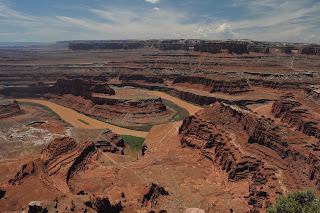Crisp mountain air greeted us as we awoke to a clear blue Colorado sky. We enjoyed Starbucks instant coffee (yes, a bit fancy for the backcountry, but as Bear Grills would say: a great morale booster to have a “creature comfort.”) and Cliff bars to fuel ourselves for a day hike along the Blue Lakes chain, up the pass toward Sneffels, and a possible summit.
We made our way above Lower Blue after a few switchbacks and just 20 minutes. The hike was significantly easier than the day before without the weight of backpacks and with the aid of another night of acclimatizing! The wildflowers above Lower Blue were equally as impressive as lakeside. They seemed to blanket the entire mountainside and provided a foreground that complemented the blue waters below and the gray mountains above.
Continuing on the trail lead us above the tree line and next to Middle Blue Lake, which was also flanked by columbines. The switchbacks toward the Blue Lakes pass at 13,000 feet finally came into view and made me question whether we’d make it. A little farther along and a stream crossing later, we were above Upper Blue Lake and the basin began to roll out beneath us as we climbed higher toward the pass.
 |
| Middle Blue Lake |
 |
| Upper Blue Lake looking north with the pass behind us |
The switchbacks up to Blue Lakes Pass begin in a wildflower area, this time filled with yellows and whites. Once out of the wildflowers, the trail narrows. Some places had been washed out making for an anxious mom as I held tight to the coonhound’s leash hoping she would stay close behind me. It turns out she has a version of 4 wheel drive that made her steadier than I!
We reached the pass around noon with Sneffels now above us to the left looking near enough to summit. But, dark clouds were thickening around us and the southwest sky looked ready to burst. We snapped some pictures in both directions and decided Sneffels would have to wait for another trip.
 |
| Blue Lakes from the pass at 13,000 feet |
 |
| Looking south into the San Juans from the pass - note the parking lot to the left! |
As we headed back down the pass, big, cold raindrops started falling followed closely by pea-sized hail. We stopped to put on raingear and met a few hikers still trying to reach the pass. They were undeterred by the storm, but we were concerned enough about lightening and the cold rain that we hurried through the switchbacks to a lower elevation. The wind picked up and blew rain and hail sideways into us. Even reaching the tree line didn’t provide much respite.
When we finally made it to the tent, Guinness was soaked to the bone and shivering. In 4 years, I’ve never seen her shiver. I dried her off and wrapped her in my down sleeping bag in the tent. She warmed quickly enough, but it was a good reminder about the need to stay dry in the mountains and to find shelter when it’s needed.
A steady rain shower continued into the evening, and we heard immense rockslides nearby, likely caused by melting snow. We went down to the lake to get a clear view of the basin but couldn’t see any danger – namely above our campsite. As others before us, I had a sense of being an uninvited guest in a wild, yet peaceful place. Nature was continuing on despite our presence. We were quiet bystanders in a place that goes on with or without (perhaps better in the latter case) human guests.
















































